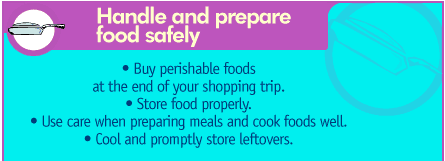|
|
 |
 
  
Almost everyone has experienced a foodborne illness at some point in time.
But do we only get sick from restaurant food? No, in fact many cases of
foodborne illnesses occur when food is prepared at home. If food is handled
and prepared safely, most of those can be avoided. All food may contain
some natural bacteria, and improper handling gives the bacteria a chance
to grow. Also, food can be contaminated with bacteria from other sources
that can make you ill. Contaminated or unclean food can be very dangerous,
especially to children and the elderly. Each year foodborne illnesses kill
up to 9,000 people. They also cause fever, stomach cramps, vomiting, and
diarrhea in almost 80 million Americans, or about 1 in 3 people.
There are four major tips you can use to prevent contaminating
food.
1. Use caution when you buy your food.
- Buy perishable food such as meat, eggs, and milk last.
- Avoid raw or unpasteurized milk.
- Because eggs, meat, seafood, and poultry are most likely to contain
bacteria, do not allow their juices to drip on other food.
- Shop for groceries when you can take food home right away so that
it does not spoil in a hot car.
2. Store your food properly.
- Store eggs, raw meat, poultry, and seafood in the refrigerator.
- Use containers to prevent contaminating other foods or kitchen surfaces.
- Your refrigerator should be set at 40°.
- Your freezer should be set at 0°.
- Regularly clean and disinfect the refrigerator and freezer.
3. Use special precautions when preparing and cooking food.
- Wash your hands and clean and disinfect kitchen surfaces before,
during and after handling, cooking, and serving food.
- Wash raw fruits and vegetables before eating them.
- Defrost froozen food on a plate either in the refrigerator or in
a microwave, but not on the counter.
- Cook food immediately after defrosting.
- Use different dishes and utensils for raw foods than you use for
cooked foods.
|
Cooking Guidelines
|
|
Eggs
|
- Cook eggs until they are firm and not runny.
- Do not eat raw or partially cooked eggs.
- Avoid eating other foods that include raw or partially cooked
eggs.
|
| Poultry |
- Cook poultry until it has an internal temperature of 180°.
- It is done when the juices run clear and it is white in the
middle.
- Never eat rare poultry.
|
| Fish |
- Cook fish until it is opaque or white and flaky.
- Cook ground meat to 160°.
|
| Meat |
- It is done when it is brown inside. This is especially critical
with hamburger meat.
|
4. Cool and promptly store leftovers after food has been served.
- Because harmful bacteria grow at room temperature
keep hot food hot at 140° or higher, and
keep cold food cold at 40° or cooler.
This is especially important during picnics and buffets.
- Do not leave perishable foods out for more than two hours.
- Promptly refrigerate or freeze leftovers in shallow containers or
wrapped tightly in bags.
Basically use common sense and when in doubt,
throw it out. It is much cheaper to throw out bad food than it is to pay
expensive medical bills or miss work.

|



